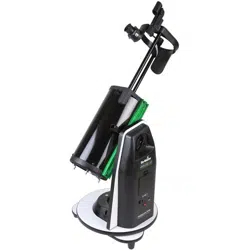Loading ...
Loading ...
Loading ...

Fig. 7.1a
Fig. 7.1b
Fig. 7.1c
Fig. 7.1d
Fig. 7.1e
18
PART VII: Proper Care for Your Telescope
7.1 Collimation
-
Correctly aligned Needs collimation
Focuser
secondary
mirror
Primary
mirror
Mirror cell
Primary
mirror
Locking
Primary mirror clip
Primary mirror clip
Primary mirror clip
Secondary
mirror
Collimation is the process of aligning the mirrors of your
telescope so that they work in concert with each other to
deliver properly focused light to your eyepiece. By
observing out-of-focus star images, you can test whether
your telescope’s optics are aligned. Place a star in the
centre of the field of view and move the focuser so that
the image is slightly out of focus. If the seeing conditions
are good, you will see a central circle of light (the Airy
disc) surrounded by a number of diffraction rings. If the
rings are symmetrical about the Airy disc, the telescope’s
optics are correctly aligned (Fig. 7.1a).
If not, the two mirrors in the telescope are not properly
aligned and collimation is needed. A collimation aid is
supplied with the accessories. It is a plastic cap with a
small hole in its centre, which fits the focuser of the
telescope when the eyepiece is removed. Let’s call it the
collimation cap.
Collimation is a painless process and works like this:
Pull off the lens cap which covers the front of the
telescope and look down the optical tube. At the bottom
you will see the primary mirror held in place by three clips
120° apart, and at the top the small oval secondary
mirror held in a support and tilted 45 toward the focuser
outside the tube wall (Fig. 7.1b).
The secondary mirror is aligned by adjusting the three
smaller screws surrounding the central bolt. The primary
mirror is adjusted by the three adjusting screws at the
back of your scope. The three locking screws beside
them serve to hold the mirror in place after collimation.
(Fig. 7.1c)
Aligning the Secondary Mirror
Point the telescope at a lit wall and insert the collimation
cap into the focuser in place of a regular eyepiece. Look
into the focuser through your collimation cap. You may
have to twist the focus knob a few turns until the reflected
image of the focuser is out of your view. lgnore the
reflected image of the collimating cap or your eye for
now, instead look for the three clips holding the primary
mirror in place. If you can’t see them, it means that you
will have to adjust the three bolts on the top of the
secondary mirror holder, with possibly an Allen wrench
or Phillip’s screwdriver. You will have to alternately
loosen one and then compensate for the slack by tight-
ening the other two. Stop when you see all three mirror
clips (Fig. 7.1d and 7.1e), Make sure that all three small
alignment screws are tightened to secure the secondary
mirror in place.
Primary mirror clip
Loading ...
Loading ...
